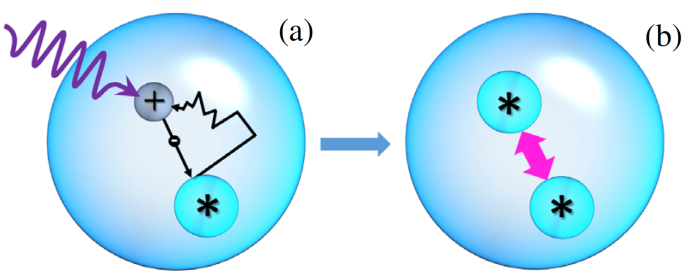When the second strike is harder than the first -- efficient indirect ionization of superfluid helium nanodroplets
Marcel Mudrich, in collaboration with a group of researchers, have had their latest research results published in a recognized journal Phys. Rev. Lett.

Ionization of matter by energetic radiation generally causes complex secondary reactions which are hard to decipher. When a primary energetic photon hits a target, one or a few electrons are emitted which then collide multiple times inside the material. These collisions can trigger a cascade of secondary processes, such as impact-excitation and -ionization of atoms and molecules nearby which creates more slow electrons, breaking of chemical bonds and formation of radicals, and the exchange of energy and charge among the excited particles. In biological tissue, radicals and slow electrons are particularly damaging due to their ability to break the strands of the DNA molecule.
In a series of experiments carried out at the synchrotron radiation facility Elettra in Italy and ASTRID2 at Aarhus University, an international team of researchers lead by Ltaief Ben Ltaief and Marcel Mudrich from IFA have recently succeeded in deciphering the full chain of processes ensuing primary photoionization of a condensed-phase model system -- superfluid helium nanodroplets. The researchers irradiated the helium nanodroplets, which were about 100 nm in size and travelled in a beam through vacuum, with extreme ultraviolet radiation. They used two different methods for detecting the emitted electrons, velocity-map imaging and high-resolution electron spectroscopy. In this way, they were able to resolve all primary and secondary ionization processes up to the level of the involved excited quantum states of the droplets and the charge states of the products.
They found that both elastic and inelastic electron collisions at the helium atoms in the nanodroplets efficiently induce further ionizations by a new so-called Interatomic Coulombic Decay (ICD) process mediated by impact excitation and charge recombination: In large helium droplets with radius >40 nm, secondary electrons are efficiently trapped in the material and recombine with their parent ions; the highly-excited species created in this way interact with one another through ICD causing their mutual ionization. This indirect ICD process even becomes the dominant channel of electron and ion emission in large helium droplets approaching the bulk limit.
While helium nanodroplets are a particularly favorable system for studying these kind of light-matter interaction processes, as the researchers have demonstrated with numerous studies before, ICD-like secondary ionization processes are expected to play an important role in other condensed-phase systems exposed to ionizing radiation as well; only that their signatures are harder to detect experimentally. These results hopefully will help to better understand how ionizing radiation causes damage in matter, which is the basis for devising better radiation protection and radiotherapies schemes.
Read more here.
